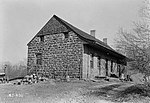Baylor Massacre
1778 in New Jersey1778 in the United States1778 murders in the United StatesBattles involving Great BritainBattles involving the United States ... and 8 more
Battles of the American Revolutionary War in New JerseyBattles of the American Revolutionary War in the New York City area after 1777Bergen County, New JerseyCemeteries in Bergen County, New JerseyConflicts in 1778Massacres in 1778Massacres in the American Revolutionary WarRiver Vale, New Jersey

The "Baylor Massacre" (also "Skirmish Near Tappan", "Rebel Post Near Old Tapan", "Tappan Massacre", and "Raid on Old Tappan") was a British attack on September 27, 1778, which surprised the 3rd Regiment of Continental Light Dragoons under the command of Colonel George Baylor during the American Revolutionary War. It occurred in the present-day town of River Vale, New Jersey. The Continentals lost 69 soldiers killed, wounded, or captured. One British soldier was killed.
Excerpt from the Wikipedia article Baylor Massacre (License: CC BY-SA 3.0, Authors, Images).Baylor Massacre
Red Oak Drive,
Geographical coordinates (GPS) Address Nearby Places Show on map
Geographical coordinates (GPS)
| Latitude | Longitude |
|---|---|
| N 41.012896 ° | E -74.008144 ° |
Address
Baylor massacar
Red Oak Drive
07675
New Jersey, United States
Open on Google Maps





